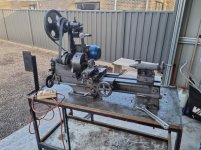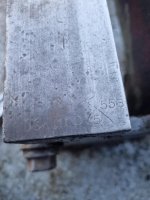Hey guys,
I've just been given this bench top lathe by my dad. He purchased it second hand in Adelaide Australia approx. 10 years ago.
He and I both have no idea what it is. There is no marking other than a few stamped numbers in the end of the bed.
It is very old, its had at least 3 coats of paint and looks to of originally been red.
It doesn't have the original motor.
The only accessories that are with it are the 3 jaw chuck, a dead center, and some change gears.
Dad said he doesn't know what the taper in the tailstock is, he thinks its something odd, the morse #2 from his other lathe doesn't fit.
I haven't had a chance to measure anything yet so cant say a whole lot more about it.
Can anyone help me identify it?
Thanks in advance,
Daniel




I've just been given this bench top lathe by my dad. He purchased it second hand in Adelaide Australia approx. 10 years ago.
He and I both have no idea what it is. There is no marking other than a few stamped numbers in the end of the bed.
It is very old, its had at least 3 coats of paint and looks to of originally been red.
It doesn't have the original motor.
The only accessories that are with it are the 3 jaw chuck, a dead center, and some change gears.
Dad said he doesn't know what the taper in the tailstock is, he thinks its something odd, the morse #2 from his other lathe doesn't fit.
I haven't had a chance to measure anything yet so cant say a whole lot more about it.
Can anyone help me identify it?
Thanks in advance,
Daniel







